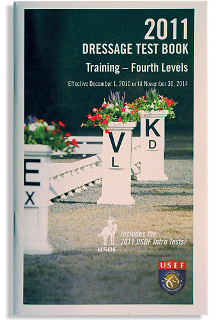Walking through my barn late at night, I say "Hello" to lots of happy equine faces peering out from their cozy stalls. This year, 2 of those horses contested USDF Region 8 championship classes. One is a boarded horse. The other is my husband's "Piper Warrior". Next year, I hope to see at least 3, maybe 4 of the horses on our farm qualify and travel to the Regionals.
For some, competing at the Regionals is an important required finale for the show year, satisfying the goals and objectives of their businesses or their riding careers. For others, it is a dream goal, sometimes achieved, sometimes not. For my own horses, it is something in between. We work throughout the year with the goal of earning qualifying scores in all competitions. Riding and placing well in the Regional Championships is more of the dream goal.
This year, we really only tried to qualify for 1st Level Open and 1st Level Freestyles. (Earning that very nice qualifying score in our 2nd Level debut was not part of the plan!) Training Level was "off limits" according to he who pays Piper's entry fees. In the end, we only qualified for the latter category. However, we still managed to do fairly well (but not great) in Year End Awards at 1st Level Open.
The Regionals this year brought the usual mix of weather. We managed to compete in fair weather all weekend, but bore witness to some monsoon style dressage. (We had our fair share of foul weather rides in April and I truly don't relish going through that again anytime soon.) And this year's competition had a very wide range of scores! Unprecedented high scores were earned by a few of our fellow competitors. Scores in the 80%. Wowwee! Very well done.
Two Freestyles
As done in previous years, I entered my freestyle partner in Saturday's "Freestyles - Level of Choice" class. Or as I call it, the "cocktails & evening entertainment" class. This class is always scheduled during cocktail hour in Ring 1. The spectators will be enjoying their VIP seats, sipping wines, munching on hors d' oeuvres. Some even watch the rides. The following morning, the USDF Freestyle Championship classes take place in the same ring.
Riding in front of an audience does not faze me, nor my horses. So, once Piper got used to seeing 5 judges booths instead of the usual spooking 1, Saturday evening went okay. We earned a fairly good score of 67.167%, enough for 3rd place, and half qualification for next year's championships. However, the next morning, while there were less spectators, there was much more activity at the FEI ring in the distance, distracting Piper to the point where being "on the bit" was not of much interest to him. He wanted to watch what was going on 500 yards away. (Horses. Sigh.) And so, with my equine dance partner popping above the bit whenever headed towards the FEI ring, we earned a 65.667% and 4th place in the USDF Region 8 First Level Freestyle Championships.
Now, Piper's freestyle to "All of Me" and "A-Train" is retired. Next year..... Maybe Queen. Maybe Abba. Not sure yet. Stay tuned.


 I've got rhythm!
I've got rhythm! Summer seems to have suddenly arrived! And with it, show season kicks back into fast and furious mode. We have several local shows lined up...
Summer seems to have suddenly arrived! And with it, show season kicks back into fast and furious mode. We have several local shows lined up... Read Each Show's Entry Requirements
Read Each Show's Entry Requirements
 In a recent issue of
In a recent issue of  For those looking for more information & statistics about helmets and safety, check out the
For those looking for more information & statistics about helmets and safety, check out the  NEDA members who are new to dressage will also find lots of basic USDF rules information. Reading the USEF Dressage Rulebook is still highly advised, but the Omnibus provides a good quick start. They will also find listings of some of the local Schooling Dressage Shows.
NEDA members who are new to dressage will also find lots of basic USDF rules information. Reading the USEF Dressage Rulebook is still highly advised, but the Omnibus provides a good quick start. They will also find listings of some of the local Schooling Dressage Shows. By the end of 2010, Piper Warrior and I had achieved our 2010 dressage goals, and then some. We made it to the 2010 USDF Region 8 Championships in 3 categories! And we finished 2010 with several National & New England Dressage Association (NEDA) year end awards, including:
By the end of 2010, Piper Warrior and I had achieved our 2010 dressage goals, and then some. We made it to the 2010 USDF Region 8 Championships in 3 categories! And we finished 2010 with several National & New England Dressage Association (NEDA) year end awards, including: The 2010 NEDA Year End Championship for USDF Freestyles came with a massive championship ribbon and a gorgeous embroidered Mountain Horse jacket. Very nice!
The 2010 NEDA Year End Championship for USDF Freestyles came with a massive championship ribbon and a gorgeous embroidered Mountain Horse jacket. Very nice! Looking at Piper this morning, it is a little difficult to imagine the woolly black warmblood will be ready to compete again in four months time, but that is part of this year's game plan. Well, that's only if he does not sell before then. (Click here to view
Looking at Piper this morning, it is a little difficult to imagine the woolly black warmblood will be ready to compete again in four months time, but that is part of this year's game plan. Well, that's only if he does not sell before then. (Click here to view 
